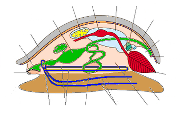Classification
Domain: Eukaryota
Eukaryotes are made up of
eukaryotic cells that contain membrane bound
organelles, such as rough endoplasmic reticulum and mitochondria.
Kingdom: Animalia
A couple of reasons why this organism is in this kingdom is because it has eukaryotic cells and is heterotrophic which are both characteristics of animals.
Phylum: Molluska

Some characteristics molluska is a bilaterally symmetrical body that is eucoelomate. Their basic body plan consists of a visceral mass, mantle, and a muscular foot.
Class: Gastropoda
 The term Gastropod means "stomach/belly foot",
thus there muscular foot is ventral to the rest of
their body and it used for locomotion.
Gastropods also have radula used for feeding and a
torsional body plan unique to Gastropods that cause
a 180º twisting of the visceral mass
(Eisenhour, Hickman, Keen,
Larson, Roberts, 2009).
The term Gastropod means "stomach/belly foot",
thus there muscular foot is ventral to the rest of
their body and it used for locomotion.
Gastropods also have radula used for feeding and a
torsional body plan unique to Gastropods that cause
a 180º twisting of the visceral mass
(Eisenhour, Hickman, Keen,
Larson, Roberts, 2009).
Order:
There is a great deal of controversy dealing with the order of Gastropoda and therefore will leave this category open. See (Johnson, 2004).
Family: Viviparidae
Sexes are separate in Viviparidae and most feed primarily on particulate detritus suspended in soft sediments (Johnson, 2004). They also have moderately large shells that are turbinate, imperforate, or subperforate with convex whorls (Walker, 1918).
Genius: Campeloma
Campeloma have a shell that is, spiral, imperforate, thick and solid (Walker, 1918). They also have a large foot and a radula composed of simple or minutely crenulated teeth (Walker, 1918).
Species: Campeloma crassula
Everything has led up to this, classifying C. crassula. C. crassula has a large heavy shell that is very ponderous and is where it gets its label as the ponderous Campeloma (Call, 1883). In Samuel Rafinesque's classification book the Journal de Physique he described this new find (C. crassula) as follows: "Shell oval. Aperture oval, truncated at base; lip reflected, united in a point behind. Umbilicus wanting. Animal unknown (Call, 1883)." He put this new organism in the Campeloma family and deemed it Campeloma crassula.

